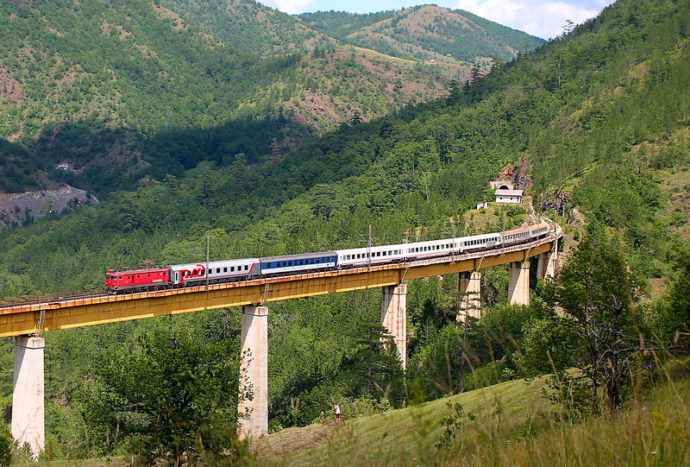Petroleum engineering may seem like an odd place to find metaphors for the field of border and borderlands studies. Yet, in her new book Border Porosities: Movement of People, Objects, and Ideas in the Southern Balkans, Rozita Dimova manages to make the analogy come alive in order to describe the relationship and borderland between the Republic of North (RN) Macedonia and Greece. In geological terms, porosity refers to the ability of a fluid or gas to move through rock due to the interconnected pores and passages formed through various processes. In anthropological terms, Dimova uses the idea to communicate the many ways that “people, objects and ideas” are not mobile in relation to national borders, but rather reproduce enduring spaces for movement and interconnectedness.
Dimova likens the railways to a ‘web of cavities and cracks,’ allowing the intended flows of trade and military might, as well as letting dissent, activism, and new political ideologies seep in.
To guide the reader into a clearer understanding of porosity, Dimova starts off with the most tangible, and perhaps most obvious, example of porosity: railroads. Against the backdrop of the ailing Ottoman Empire and the rise of ambitious, eastward-looking European railroad companies, the first chapter tells the story of the Thessaloniki (Greece) to Mitrovica (Kosovo) railroad line. Initially intended for economic development and the movement of resources out of the Balkan hinterlands and into Ottoman ports, the line also served to catalyze tensions between Balkan separatists and their rulers in Istanbul. During the first Balkan war, in which Greece, Bulgaria, Serbia and Montenegro fought for independence, the railways provided both a means of troop transportation to the Ottomans and a convenient target for Balkan separatists. Throughout the 20th century, the lines maintained a role as a strategic military tool, a focal point for trade and travel between the Balkans, and even a site of transnational labor organization between railroad workers. Dimova likens the railways to a “web of cavities and cracks,” allowing the intended flows of trade and military might, as well as letting dissent, activism, and new political ideologies seep in.
It would be over simplistic to consider border porosity as simply a material condition. In further chapters, Dimova lays out an imaginative, almost fantastical porosity, brought about in relation to the possibilities created by different economic circumstances on either side of the Greek/RN Macedonian border. On the one hand, Greeks can travel to their lower income neighbor to purchase otherwise unaffordable goods, beauty treatments and luxury entertainment. In exchange, Macedonians vacationing or owning property in Greece gain the opportunity to exhibit and reproduce the markers of middle-class prosperity. Furthermore, the entanglements between Macedonian citizens who interact with Greece through tourism and property ownership, ethnically Macedonian Greek citizens, and child refugees who left Greece for Communist Balkan countries during the Greek Civil War are all classified as sorts of ‘human sediments,’ carrying pieces of one homeland and depositing them into another. Dimova also writes on the influence and support between environmental groups opposing open-pit mining on both sides of the border, and their ability to build connections through common but decentralized political projects. In these ways, cross-border movement and shared sentiments are facilitated, through both brief, relatively superficial ways and through lifelong and even intergenerational connections.
Dimova lays out an imaginative, almost fantastical porosity, brought about in relation to the possibilities created by different economic circumstances on either side of the Greek/RN Macedonian border.
While overall, the concept of border porosity maintains its value as a framework for border ethnography, the application in the book’s final chapter falls into the trap of being slightly overstretched. Until this point, Dimova has focused on her initial goal of describing cross border mobility, here she arrives at a conundrum. Rather than being two separate but interconnected entities, Greece and RN Macedonia share a history, a national hero in the form of Alexander the Great, and a claim to the historical territory of ancient Macedonia. The quest to claim this heritage fuels animosity between the two governments while also becoming a tool for producing national identity in RN Macedonia particularly, and eventually, even a smokescreen for political corruption. During the 2016 Colorful Revolution in Skopje, pro-democracy and multi-ethnic protestors attacked a monument that had been constructed in a show of ownership over Macedonian antiquity, both paving the way for rapprochement with Greece and emphasizing the multiple layers of their history, including their Ottoman and Yugoslavian past. While the concept of porosity and permeability remains relevant, Dimova also mixes it with Sarah Green’s “traces and tidemarks” framework of border analysis as well as Mikhail Bahktin’s theories on communication. The result is that the porosity metaphor feels simultaneously all encompassing and slightly cumbersome or made to be one-size-fits-all.
Readers may be well advised to familiarize themselves with Balkan history before digging into Border Porosities. In just 149 pages, Dimova touches on points from over 2,400 years of regional history, starting from the reign of Phillip II of Macedon (382 BCE). She manages to reference the Hellenistic age, the Ottoman Conquest, the Balkan wars, the World Wars, the Greek Civil war, Yugoslavia, and the Mediterranean migrant “crisis” to end up in a description the 21st century in which she describes the ongoing relationships between the two countries and the supra-national power structures of NATO and the European Union. As such, the book can be a great motivation for further historical inquiry for those with a border studies background, an opportunity to flesh out finer points for those already familiar with the region, or a source of confusion for a reader with neither point of reference.
For all her details and rich analysis, Dimova rarely pinpoints where Greece ends and Macedonia begins. Overlaps in shared history and heritages, language, ethnicity, geography, political ambition and social values suggest less that they are two separate entities, and more that the permeability between the two countries is so prevalent that it can be difficult to distinguish the two. In illustrating this, Border Porosities meets its stated goal of demonstrating that “borders, infused with political, economic, and symbolic features, can simultaneously become the terrain for exclusionary and emancipatory practices for the actors who are involved in border crossing on an everyday level and also be affected by larger political and symbolic disputes.”



